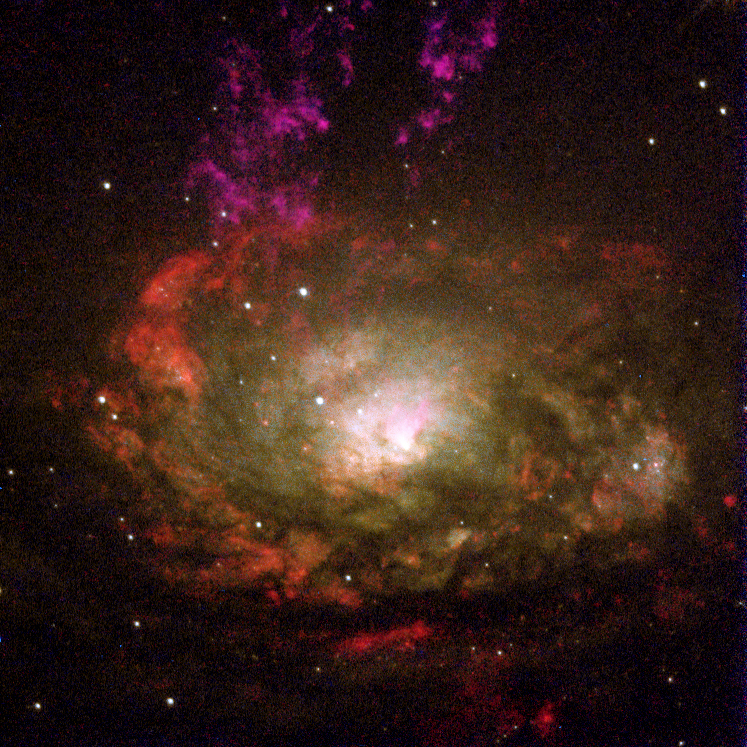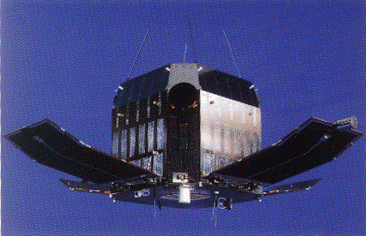|
Ginga (satellite)
ASTRO-C, renamed Ginga (Japanese for 'galaxy'), was an X-ray astronomy satellite launched from the Kagoshima Space Center on 5 February 1987 using M-3SII launch vehicle. The primary instrument for observations was the Large Area Counter (LAC). Ginga was the third Japanese X-ray astronomy mission, following Hakucho and Tenma (also Hinotori satellite - which preceded Ginga - had X-ray sensors, but it can be seen as a heliophysics rather than X-ray astronomy mission). Ginga reentered the Earth's atmosphere on 1 November 1991. Instruments * Large Area Proportional Counter (LAC 1.5-37 keV) * All-Sky Monitor (ASM 1-20 keV) * Gamma-ray Burst Detector (GBD 1.5-500 keV) Highlights *Discovery of transient Black Hole Candidates and study of their spectral evolution. *Discovery of weak transients in the galactic ridge. *Detection of cyclotron features in 3 X-ray pulsars: 4U1538-522, V0332+53, and Cep X-4. *Evidence for emission and absorption Fe feature in Seyfert probing reproces ... [...More Info...] [...Related Items...] OR: [Wikipedia] [Google] [Baidu] |
Hakucho
Hakucho (also known as CORSA-b before launch; CORSA stands for Cosmic Radiation Satellite) was Japan's first X-ray astronomy satellite, developed by the Institute of Space and Aeronautical Science (then a division of the University of Tokyo). It was launched from the Kagoshima Space Center by the ISAS M-3C rocket on the M-3C-4 mission on February 21, 1979 and reentered the atmosphere on April 15, 1985. Hakucho was a replacement for the CORSA satellite which failed to launch due to rocket failure on February 4, 1976. Highlights *Discovery of soft X-ray transient Cen X-4 and Aql X-1 *Discovery of many burst sources *Long-term monitoring of X-ray pulsar (e.g. Vela X-1) *Discovery of 2 Hz variability in the Rapid Burster later named Quasi Period Oscillation. See also * Timeline of artificial satellites and space probes This Timeline of artificial satellites and Space probe A space probe is an artificial satellite that travels through space to collect scientific data. ... [...More Info...] [...Related Items...] OR: [Wikipedia] [Google] [Baidu] |
Satellites Formerly Orbiting Earth
A satellite or artificial satellite is an object intentionally placed into orbit in outer space. Except for passive satellites, most satellites have an electricity generation system for equipment on board, such as solar panels or radioisotope thermoelectric generators (RTGs). Most satellites also have a method of communication to ground stations, called transponders. Many satellites use a standardized bus to save cost and work, the most popular of which is small CubeSats. Similar satellites can work together as a group, forming constellations. Because of the high launch cost to space, satellites are designed to be as lightweight and robust as possible. Most communication satellites are radio relay stations in orbit and carry dozens of transponders, each with a bandwidth of tens of megahertz. Satellites are placed from the surface to orbit by launch vehicles, high enough to avoid orbital decay by the atmosphere. Satellites can then change or maintain the orbit by propulsion, ... [...More Info...] [...Related Items...] OR: [Wikipedia] [Google] [Baidu] |
Satellites Of Japan
A satellite or artificial satellite is an object intentionally placed into orbit in outer space. Except for passive satellites, most satellites have an electricity generation system for equipment on board, such as solar panels or radioisotope thermoelectric generators (RTGs). Most satellites also have a method of communication to ground stations, called transponders. Many satellites use a standardized bus to save cost and work, the most popular of which is small CubeSats. Similar satellites can work together as a group, forming constellations. Because of the high launch cost to space, satellites are designed to be as lightweight and robust as possible. Most communication satellites are radio relay stations in orbit and carry dozens of transponders, each with a bandwidth of tens of megahertz. Satellites are placed from the surface to orbit by launch vehicles, high enough to avoid orbital decay by the atmosphere. Satellites can then change or maintain the orbit by propulsion, ... [...More Info...] [...Related Items...] OR: [Wikipedia] [Google] [Baidu] |
X-ray Telescopes
An X-ray telescope (XRT) is a telescope that is designed to observe remote objects in the X-ray spectrum. In order to get above the Earth's atmosphere, which is opaque to X-rays, X-ray telescopes must be mounted on high altitude rockets, balloons or artificial satellites. The basic elements of the telescope are the optics (focusing or collimating), that collects the radiation entering the telescope, and the detector, on which the radiation is collected and measured. A variety of different designs and technologies have been used for these elements. Many of the existing telescopes on satellites are compounded of multiple copies or variations of a detector-telescope system, whose capabilities add or complement each other and additional fixed or removable elements (filters, spectrometers) that add functionalities to the instrument. Optics The most common methods used in X-ray optics are grazing incidence mirrors and collimated apertures. Focusing mirrors The utilization of X-r ... [...More Info...] [...Related Items...] OR: [Wikipedia] [Google] [Baidu] |
Space Telescopes
A space telescope or space observatory is a telescope in outer space used to observe astronomical objects. Suggested by Lyman Spitzer in 1946, the first operational telescopes were the American Orbiting Astronomical Observatory, OAO-2 launched in 1968, and the Soviet Orion 1 ultraviolet telescope aboard space station Salyut 1 in 1971. Space telescopes avoid the filtering and distortion ( scintillation) of electromagnetic radiation which they observe, and avoid light pollution which ground-based observatories encounter. They are divided into two types: Satellites which map the entire sky (astronomical survey), and satellites which focus on selected astronomical objects or parts of the sky and beyond. Space telescopes are distinct from Earth imaging satellites, which point toward Earth for satellite imaging, applied for weather analysis, espionage, and other types of information gathering. History Wilhelm Beer and Johann Heinrich Mädler in 1837 discussed the advantages of ... [...More Info...] [...Related Items...] OR: [Wikipedia] [Google] [Baidu] |
Galactic Center
The Galactic Center or Galactic Centre is the rotational center, the barycenter, of the Milky Way galaxy. Its central massive object is a supermassive black hole of about 4 million solar masses, which is called Sagittarius A*, a compact radio source which is almost exactly at the galactic rotational center. The Galactic Center is approximately away from Earth in the direction of the constellations Sagittarius, Ophiuchus, and Scorpius, where the Milky Way appears brightest, visually close to the Butterfly Cluster (M6) or the star Shaula, south to the Pipe Nebula. There are around 10 million stars within one parsec of the Galactic Center, dominated by red giants, with a significant population of massive supergiants and Wolf–Rayet stars from star formation in the region around 1 million years ago. The core stars are a small part within the much wider galactic bulge. Discovery Because of interstellar dust along the line of sight, the Galactic Center cannot be studied at v ... [...More Info...] [...Related Items...] OR: [Wikipedia] [Google] [Baidu] |
Seyfert Galaxy
Seyfert galaxies are one of the two largest groups of active galaxies, along with quasars. They have quasar-like nuclei (very luminous, distant and bright sources of electromagnetic radiation) with very high surface brightnesses whose spectra reveal strong, high-ionisation emission lines, but unlike quasars, their host galaxies are clearly detectable. Seyfert galaxies account for about 10% of all galaxies and are some of the most intensely studied objects in astronomy, as they are thought to be powered by the same phenomena that occur in quasars, although they are closer and less luminous than quasars. These galaxies have supermassive black holes at their centers which are surrounded by accretion discs of in-falling material. The accretion discs are believed to be the source of the observed ultraviolet radiation. Ultraviolet emission and absorption lines provide the best diagnostics for the composition of the surrounding material. Seen in visible light, most Seyfert galaxies ... [...More Info...] [...Related Items...] OR: [Wikipedia] [Google] [Baidu] |
X-ray Pulsar
X-ray pulsars or accretion-powered pulsars are a class of astronomical objects that are X-ray sources displaying strict periodic variations in X-ray intensity. The X-ray periods range from as little as a fraction of a second to as much as several minutes. Characteristics An X-ray pulsar consists of a magnetized neutron star in orbit with a normal stellar companion and is a type of binary star system. The magnetic-field strength at the surface of the neutron star is typically about 108 Tesla, over a trillion times stronger than the strength of the magnetic field measured at the surface of the Earth (60 μT). Gas is accreted from the stellar companion and is channeled by the neutron star's magnetic field on to the magnetic poles producing two or more localized X-ray hot spots, similar to the two auroral zones on Earth, but far hotter. At these hotspots the infalling gas can reach half the speed of light before it impacts the neutron star surface. So much gravitational potentia ... [...More Info...] [...Related Items...] OR: [Wikipedia] [Google] [Baidu] |
Hinotori (satellite)
Hinotori, also known as ASTRO-A before launch, was a Japanese X-ray astronomy satellite. It was developed by the Institute of Space and Astronautical Science (ISAS). Its primary mission was to study of solar flares emanating from the Sun during the solar maximum. It was launched successfully on February 21, 1981 using a M-3S rocket as the vehicle from Uchinoura Space Center The is a space launch facility in the Japanese town of Kimotsuki, Kagoshima Prefecture. Before the establishment of the JAXA space agency in 2003, it was simply called the (KSC). All of Japan's scientific satellites were launched from Uchino ... (known at the time as Kagoshima). After the start of normal operation, it observed a large solar flare and, a month later, succeeded in observing 41 flares of many sizes from the Sun. It reentered the atmosphere on July 11, 1991.ISAS "Solar Observation HINOTORI (ASTRO-A)" retrieved 2014-12-23. The name Hinotori is the Japanese word for Phoenix. Instruments ... [...More Info...] [...Related Items...] OR: [Wikipedia] [Google] [Baidu] |
Tenma
Tenma, known as ASTRO-B before launch (COSPAR 1983-011A, SATCAT 13829), was a Japanese X-ray astronomy satellite, developed by the Institute of Space and Astronautical Science (ISAS) is a Japanese national research organization of astrophysics using rockets, astronomical satellites and interplanetary probes which played a major role in Japan's space development. Since 2003, it is a division of Japan Aerospace E .... It was launched on February 20, 1983, using a M-3S rocket on the M-3S-3 mission. Battery failure in July 1984 caused the operation to become limited, and continuing problems lead to the termination of X-ray observation in 1985. It reentered the atmosphere on January 19, 1989 (other sources, for example the NORAD catalog of satellites, say decay date (the day it stopped working)was 17 May 1988). Highlights * Discovery of the iron helium-like emission from the galactic ridge * Iron line discovery and/or study in many LMXRB, HMXRB and AGN * Discovery of a ... [...More Info...] [...Related Items...] OR: [Wikipedia] [Google] [Baidu] |
X-ray
An X-ray, or, much less commonly, X-radiation, is a penetrating form of high-energy electromagnetic radiation. Most X-rays have a wavelength ranging from 10 picometers to 10 nanometers, corresponding to frequencies in the range 30 petahertz to 30 exahertz ( to ) and energies in the range 145 eV to 124 keV. X-ray wavelengths are shorter than those of UV rays and typically longer than those of gamma rays. In many languages, X-radiation is referred to as Röntgen radiation, after the German scientist Wilhelm Conrad Röntgen, who discovered it on November 8, 1895. He named it ''X-radiation'' to signify an unknown type of radiation.Novelline, Robert (1997). ''Squire's Fundamentals of Radiology''. Harvard University Press. 5th edition. . Spellings of ''X-ray(s)'' in English include the variants ''x-ray(s)'', ''xray(s)'', and ''X ray(s)''. The most familiar use of X-rays is checking for fractures (broken bones), but X-rays are also used in other ways. ... [...More Info...] [...Related Items...] OR: [Wikipedia] [Google] [Baidu] |







